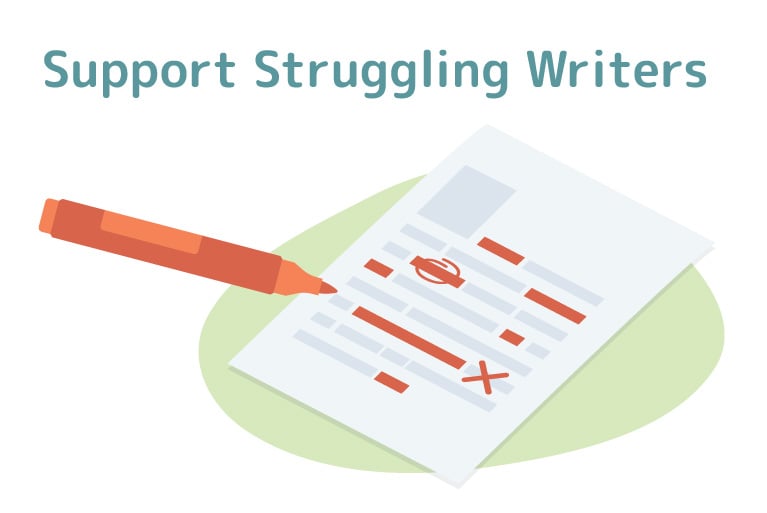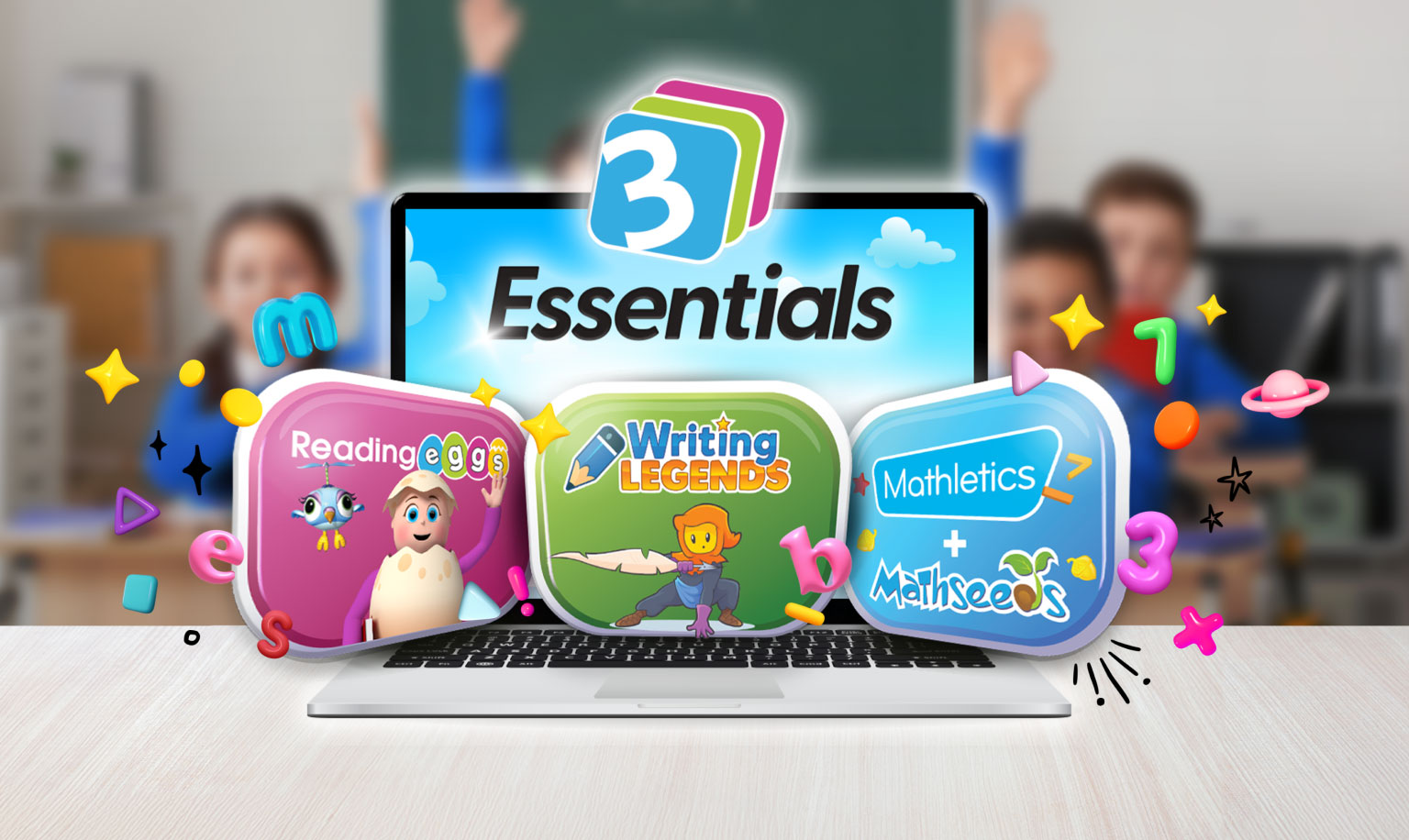
You’ve spent weeks unpacking symbolism and sparking creative fires. You’ve pushed students to embrace new perspectives and mine the rich depths of meaning in a powerful text.
And now that the work has been turned in – you’ve been sent crashing back to earth.
Forget the difference between simile and metaphor – your students are struggling to tell ‘their’ from ‘there’. Even common words are being misspelled, and the overall structure of their writing makes as much sense as an abstract painting.
But the part that hurts the most?
You don’t know how to help.
It’s a familiar scenario for secondary English teachers. Most of us never learned how to teach the nuts and bolts of writing, and the curriculum assumes most students tick that box in primary school (if only).
That’s why we’ve created this cheat sheet of strategies for supporting students’ spelling, grammar, punctuation, and paragraphing. We’ve kept them easy and actionable so you can support the struggling writers in your class, even if you’ve never done formal writing instruction before.
Spelling
For students who are still struggling to spell, it helps to take a note out of the primary teacher’s book and use a combination morphemic, visual, phonological, and etymological strategies.
And if that sounds like gibberish, don’t worry – we’ll keep it simple.
Morphemic spelling strategies
Morphemic strategies link the spelling of words to their meanings. They’re useful for older students who already have an extensive vocabulary but struggle with spelling. Consider doing things like:
- Making lists of commonly misspelled homophones (words that sound identical but have different meanings and spellings, e.g. stair/stare)
- Explicitly teaching suffixes and prefixes, and then having students attach them to common base words.
- Letting students discover patterns of meaning across common spellings (e.g. what do words ending in -er have in common, in terms of their meaning?)
Etymological spelling strategies
Etymological strategies trace spelling back to Greek and Latin root words. Once students understand the root words, all the vocabulary based off those root words becomes far easier to spell.
This forms the basis for an easy and engaging ‘etymological hunt’. Here’s how it works:
- Group students into threes, and give each group a Greek or Latin word root plus its definition (e.g. “pathos” which means ‘suffering’, ‘experience’, or ‘emotion’ in Greek).
- Challenge each group to find as many English words as they can linking back to this root.
- Have each group share their findings, along with an explanation of how the meaning of the English word relates back to the root.
Visual spelling strategies
Sometimes looking at a word is all students need to do to figure out which spelling is correct. Teach this explicitly by giving them self-questions to ask when spelling an unfamiliar word, such as:
- Does this look right?
- Are there any alternative spellings I could have used?
- Which part looks a bit ‘off’?
- Do any bits of the word look familiar to spellings I already know?
Good news: these self-monitoring strategies will help other areas of writing beyond spelling. Anytime students are unsure of what they’re putting on paper, they’ll be able to pause and self-assess instead of giving up.
Phonological spelling strategies
Phonological strategies refer to the sounds of words to determine their spelling.
You might not be singing aloud as a class or running phonics lessons in high school, but you can still leverage these strategies by:
- Having students compile lists of rhyming words and comparing their spellings (great for aspiring rappers).
- Taking turns reading aloud when working through a text.
- Encouraging students to spell phonetically when they don’t know the correct spelling, and then using this as a basis for correction.
Grammar
Remember what the subjunctive mood is? A transitive verb?
… We don’t either.
But that’s OK. You won’t need jargon or a linguistics degree to improve your students’ grammar if you use these simple strategies:
Colour coding
Colour code texts for parts of speech and different clauses. It brightens up the otherwise dull process of underlining, and students can highlight patterns even if they don’t have all the grammatical vocabulary just yet.
Charades
Have a game of charades but categorise the mystery words according to their parts of speech. For example, you might start with adverbs and have students walk ‘carefully’, ‘hastily’, or ‘tranquilly’ (up their vocab at the same time). Based on their actions, the rest of the class guess which adverb describes their walk.
Find patterns
Help students with syntax by focusing on patterns of sentence structure that are easy to describe.
Take this sentence as an example:
After a long day, Harry picked up his bag and headed for home, thinking of the essay that awaited him.
Most students will be able to identify Harry and his actions as the main subject of the sentence, while the first part and last parts provide extra information that couldn’t exist alone.
You can then turn this into a grammatically correct formula:
Background information –> main subject –> extra information about the subject
That’s a lot easier than fussing over prepositional and subordinate clauses, and it’s no less true. See what other formulas your students can identify.
Punctuation
Correcting capital letters and full stops can often seem like an uphill battle, but there are a few things you can do take make proper punctuation stick.
Use ‘messenger speak’
Ask students what punctuation they already use when they’re tapping away to their friends and they’ll come to realise that they use more than they let on. Consider:
- Breaks between short messages
- Ellipses
- ALL CAPS
- Emojis
- Stops. For. Emphasis.
You can then discuss how the same punctuation devices can be used or adapted for more formal writing, and introduce others by explaining that they serve the same purpose – adding emotion, pace, and meaning to our words.
Practice reading aloud
Reading aloud will help students understand how punctuation communicates pace and inflection, so make it a regular part of your lessons whenever you’re working through a text.
Round Robin Reading is one way to ensure everyone gets a turn. Start by reading aloud yourself (don’t forget to set a good example by amping up the drama and the volume!) and then let students take turns reading paragraphs.
Tip: set small and simple passages aside for your struggling readers. They’ll still learn by listening to others and reading along, and they won’t be racked by anxiety.
Paragraphing
The best way to teach paragraphing is by keeping it systematic and formulaic. This doesn’t mean students have to produce boringly predictable writing, but it means they’re never at a loss as to what they should be doing on a sentence by sentence basis.
Use a paragraph formula for non-fiction writing
The following paragraph formula works well for most types of analytical or interpretive writing:
- Topic sentence clearly and concisely outlining what the paragraph will be about
- A piece of evidence or argument supporting the central point
- An explanation of this evidence or argument
- Repeat steps 3 & 4 to build the main body of the paragraph
- A concluding sentence that summarizes the central point of the paragraph again and segues into the next.
This is just one suggested structure – you might like to adapt it depending on the subject matter or genre of your students’ writing.
Group paragraphing
Students can use a formula like the one above to generate a single paragraph as a group. Here’s how:
- Make sure students have a topic first (this works particularly well as you are transition from an ideas-discussion into writing
- Create groups of 4-5 and then assign each student a different part of the paragraph to write (e.g. one person does the topic sentence, one person inputs the first piece of evidence, etc.).
- Give students some time to collectively plan their approach.
- Students write their part of the paragraph on a strip of card.
- The strips of card are arranged vertically to create a full paragraph.
It takes time, but this activity works because it requires them to focus super closely on each individual component of the paragraph anatomy.
Tip: extend the activity by having students ‘smooth out’ their paragraph by adding linking words to make it flow together. This stops it from sounding choppy and disjointed, and it’s a good opportunity to discuss what makes some writing more pleasurable to read than others.
Use model texts
Take a paragraph from a model text and colour code the different parts – first as a class, then as an individual exercise.
You might not be able to precisely label each part of the paragraph, but encourage students to verbally explain what they think the writer is doing in each section. They can then take the same structure and apply it to their own writing.
Tips for assessing secondary writing
Teaching writing is one thing – assessing it and providing helpful feedback is another. (Hint: going crazy with the red pen will probably do more harm than good).
Here’s what you can do to make the assessment process easier for you, and less painful for your students:
Make your intentions clear
If you’re looking to assess students’ writing, let them know in advance. Talk them through the criteria and prepare them for it so they’re given the chance to succeed.
By the same token, resist the urge to circle every misplaced piece of punctuation and absent capital letter when you haven’t made writing the assessment focus. It detracts from the feedback you’re really trying to give, and it’s a blow to student confidence too.
Split your criteria
A single mark for ‘written expression’ doesn’t tell students much. Break down the criteria so that students can see precisely which aspect of their writing needs work. You might even use the sections of this article (grammar, spelling, paragraphing, punctuation) as a guide.
Find patterns
Is a student continually misspelling a group of common words?
Is it run-on sentences that are making their work so hard to read?
Look for the mistakes your students keep repeating. This will make it much easier to deliver targeted feedback and specific strategies that help.
Need more help with supporting your students’ writing?
Transforming students into skilled writers doesn’t happen overnight.
And for teachers who already have their hands full getting through the conceptual side of the curriculum, it sometimes seems like an impossible job.
But if you leverage a curriculum-aligned writing program for secondary students, you can put them on the path to writing success without lagging behind on other outcomes.
Take our online writing program, WordFlyers, for example. It’s packed full of gamified activities students can use at home and in school to hone their command of the written word.
The best part? Marking happens automatically, and it’s sent straight to your inbox. So you can monitor and support students who need that extra writing push without creating extra work for yourself.
Interested? Find out more by checking out the link below.










